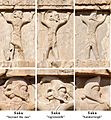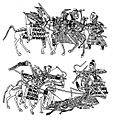Saka facts for kids
 Approximate extent of East Iranian languages the 1st century BCE is shown in orange. |
|
Quick facts for kids Total population |
|
|---|---|
| (Unknown) | |
| Regions with significant populations | |
| Eastern Europe Central Asia Northern India |
|
| Languages | |
| Scythian language | |
| Religion | |
| Animism | |
| Related ethnic groups | |
The Sakas were a population of Iranian nomadic tribesmen lived in the plains of Eurasia from Eastern Europe to China, from the Old Persian Period to the Middle Persian Period. Then Turkic language speakers took their place.
The ancient Greeks called the Sakas the Scythians.
Images for kids
-
For the Achaemenids, there were three types of Sakas: the Sakā tayai paradraya ("beyond the sea", presumably between the Greeks and the Thracians on the Western side of the Black Sea), the Sakā tigraxaudā ("with pointed caps"), the Sakā haumavargā ("Hauma drinkers", furthest East). Soldiers of the Achaemenid army, Xerxes I tomb detail, circa 480 BC.
-
A document from Khotan written in Khotanese Saka, part of the Eastern Iranian branch of the Indo-European languages, listing the animals of the Chinese zodiac in the cycle of predictions for people born in that year; ink on paper, early 9th century
-
Scythia and the Parthian Empire in about 170 BC (before the Yuezhi invaded Bactria).
-
Silver coin of the Indo-Scythian King Azes II (ruled c. 35–12 BC). Note the royal tamga on the coin.
See also
 In Spanish: Sacas (tribu) para niños
In Spanish: Sacas (tribu) para niños











